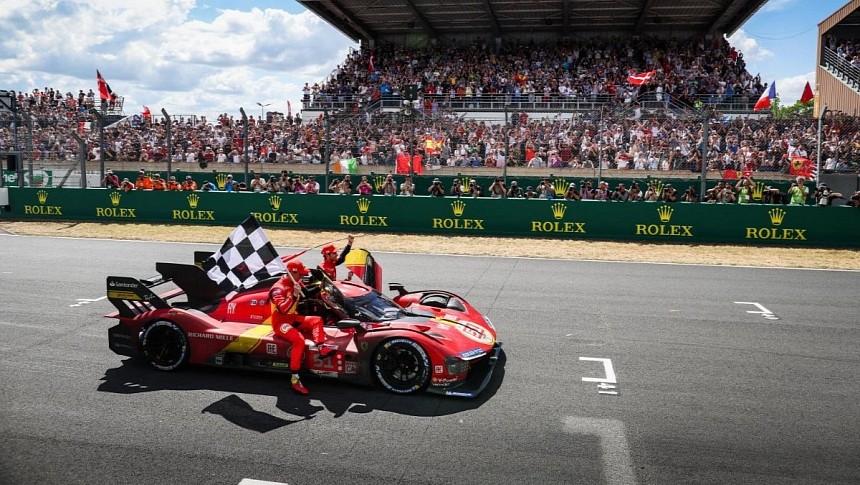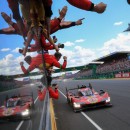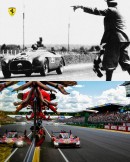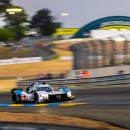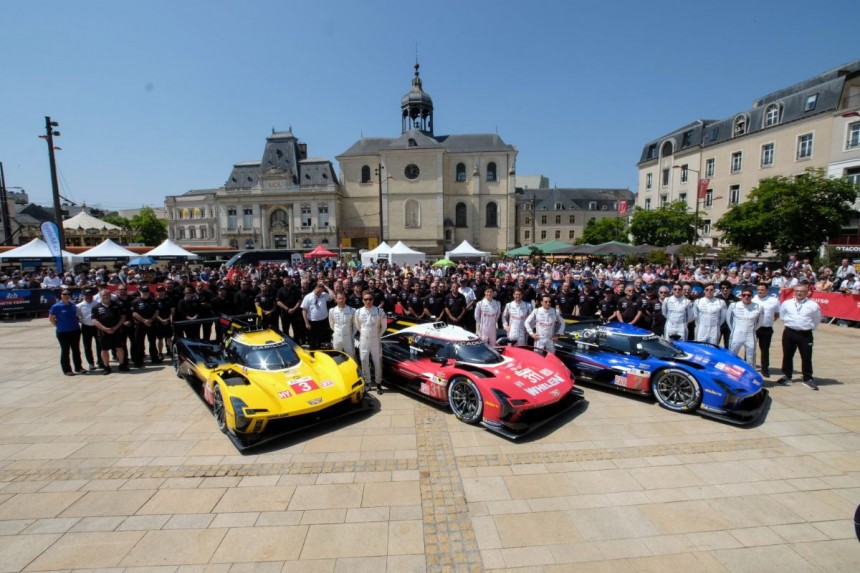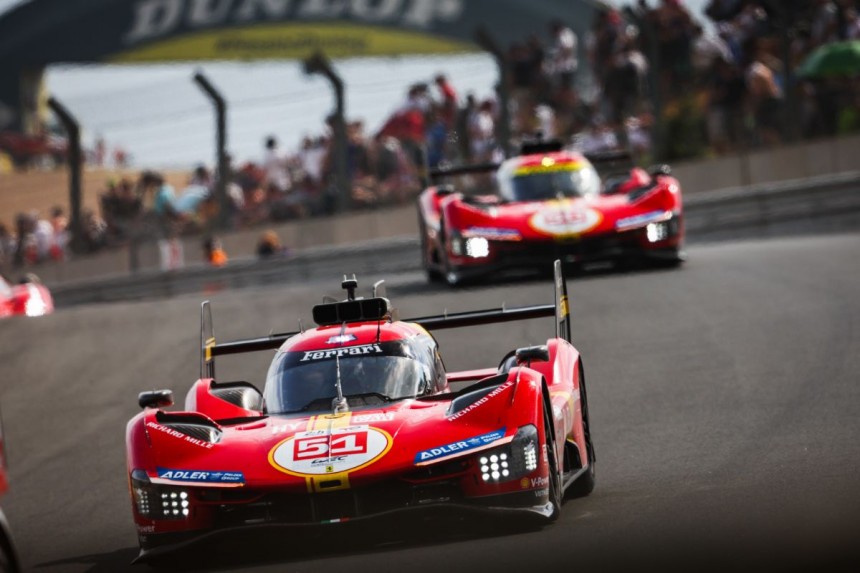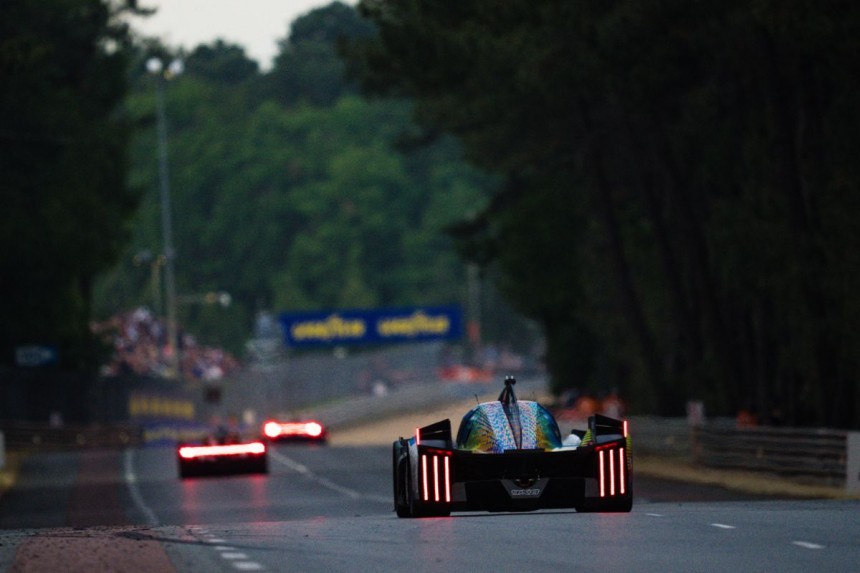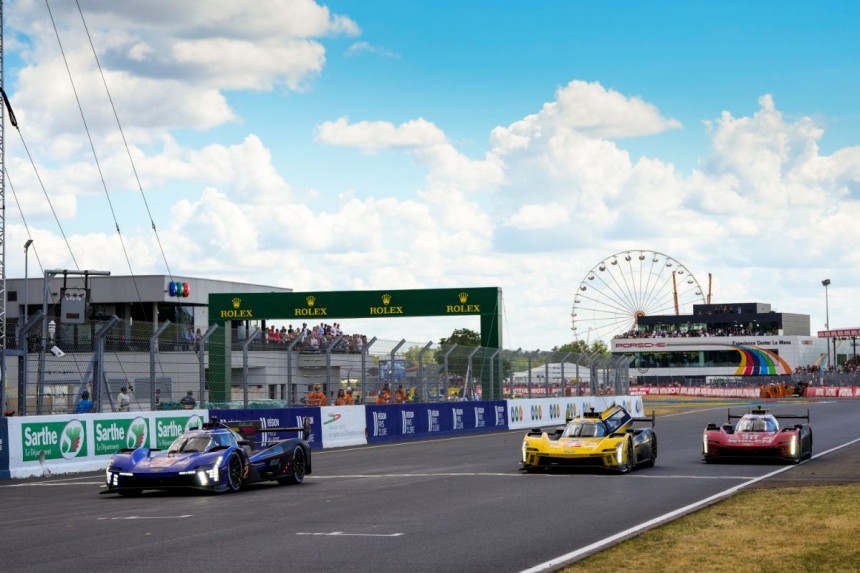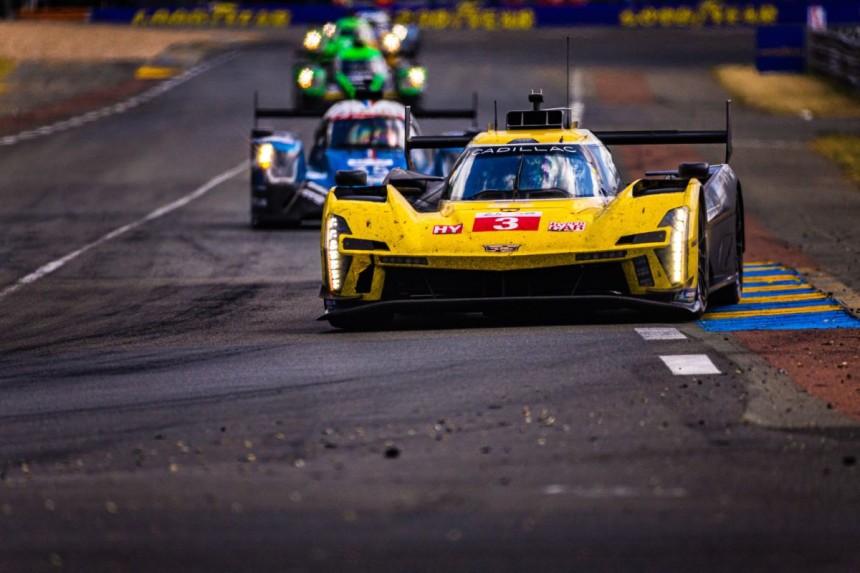In the realm of Le Mans 24 Hours, where Toyota reigned supreme, a glimmer of opportunity beckoned for the daring newcomers in the Hypercar realm. After an absence of half a century, Ferrari made its comeback at the momentous centenary race. Yet, their journey was paved with crashes, mechanical terrors, and the relentless trials presented by the formidable Circuit de la Sarthe.
Could fate have woven a more captivating conclusion to the centenary chapter of Le Mans 24 Hours? Unlikely, for the headlines would not have resonated with the same resounding impact across the globe. Ferrari seized the moment, delivering a resounding triumph on their maiden attempt with the new 499P Le Mans Hypercar. This victory marked their return to the prototype ranks after a hiatus spanning five decades. Adding to the allure, Alessandro Pier Guidi, James Calado, and Antonio Giovinazzi emerged triumphant after an exhilarating battle against the formidable Toyotas.
Crossing the finish line, the #51 Ferrari claimed victory, leaving the #8 Toyota GR010 HYBRID LMH, piloted by Sebastien Buemi, Brendon Hartley, and Ryo Hirakawa, trailing by a mere 80 seconds. It was a race fraught with incidents and attrition, as two rainstorms, three safety cars, and five virtual Full Course Yellows influenced its course. The Italian manufacturer showcased their dominance on Sunday morning, poised to secure their first overall Le Mans victory since 1965. However, Le Mans is renowned for its last-minute drama.
Yearning for a sixth consecutive Le Mans triumph, Toyota surged back into contention in the 18th hour. Initially trailing the 499P by a substantial margin, the GR010 began to close the gap as temperatures soared. An electronic glitch further hindered Ferrari, costing them precious time in the pits. Capitalizing on the opportunity, Buemi momentarily snatched the lead by a slender margin. Yet, in a matter of laps, Pier Guidi swiftly maneuvered his way past, tilting the scales in Ferrari's favor. A delicate balance teetered between the two contenders.
With two and a half hours remaining, Hartley extended his stint behind the wheel, urged to push beyond the usual triple stint. Equipped with fresh Michelin medium-compound slicks, he began to chip away at Calado's advantage. A once-fifteen-second gap diminished to a mere nine seconds as he relentlessly pursued the Italian machine. Neither car opted for fresh tires at their subsequent pit stops when Hirakawa replaced Hartley. The young Japanese driver received the call to unleash "maximum attack," as described by his Kiwi teammate.
However, fate intervened. Three laps later, Hirakawa locked up under braking at the tight Arnage right-hander, resulting in front and rear body damage as the #8 Toyota careened into the barriers. A two-minute pit stop for repairs left them trailing the Ferrari by over three minutes. The battle for the race had reached its conclusive end.
Yet, the saga of this race still had one final twist. Throughout the duration, all five manufacturers in the Hypercar class had led at some point, adding an unpredictable layer to the narrative. However, Toyota was unable to capitalize on their position. Just as the clock neared its final minutes, the electronic glitch that had plagued Pier Guidi earlier resurfaced during the Ferrari's last pit stop. Swiftly, the driver, the Ferrari engineers, and the AF team sprang into action, resolving the issue with remarkable efficiency. Merely 30 seconds were lost as Pier Guidi executed the necessary power cycle to reboot the car's systems. The lingering question remained: Would Toyota have seized the advantage had Hirakawa not encountered the unfortunate mishap? Alas, the answer to such a hypothetical will forever remain shrouded in uncertainty.
Within the realm of pits, Pier Guidi's precious seconds slipped away, marking the culmination of heart-stopping moments for Ferrari. Defying their underdog status in the fourth round of the WEC, they navigated the pre-race Balance of Performance adjustment that impacted Toyota the hardest. As Calado buried his face in his hands, Ferrari's racing technical chief, Ferdinando Cannizzo, reassured the team's composure. This time, concerns were quelled. Earlier, Pier Guidi had endured a spin at the first chicane on the illustrious Mulsanne Straight during the ninth hour. Fortunately, quick assistance from marshals prevented them from losing a lap. The subsequent safety car period rendered his misfortune inconsequential in the race's context.
The sister car, shared by Antonio Fuoco, Nicklas Nielsen, and Miguel Molina, encountered a problem in the tenth hour that could drastically alter Ferrari's prospects. The #50 499P had already endured a setback, undergoing a reboot due to a stone piercing the hybrid cooling system. Forced to replace the radiator, the team lost a staggering thirty minutes, plummeting outside the top ten. Nevertheless, the car's resilience and the challenges faced by other Hypercar competitors propelled them to secure a fifth place at the checkered flag. Fuoco's setbacks leveled the playing field in the Ferrari versus Toyota rivalry. Toyota had already reduced its fleet to a single car due to an incident indirectly linked to Pier Guidi's earlier mishap. A Slow Zone, with an 80km/h (50mph) speed limit and no overtaking under virtual safety car conditions, remained in effect from Tertre Rouge to the first chicane on the straight.
Amidst the preparatory area, Kamui Kobayashi found himself in a dramatic situation, needing to abruptly decelerate to avoid overtaking Giedo van der Garde's Graff Racing ORECA-Gibson 07 LMP2. Unfortunately, Louis Prette's JMW Motorsport Ferrari GTE Evo forcefully struck him from behind and experienced a lesser impact from Memo Rojas in one of the Signatech team's ORECAs. Both rear tires suffered punctures, and the left rear driveshaft snapped. Kobayashi's hopes of reaching the pits were futile.
Troubling times ensued for Toyota. The #8 car, initially leading their charge, succumbed to an overheating issue. Vasselon revealed post-race that the team feared losing two cars in quick succession. Another unexpected obstacle materialized for the #8 Toyota—an encounter with a small but impactful rodent caused nose damage during the night. Vasselon quipped that the length of the squirrel's tail found within the car hinted at its involvement. The time lost by Toyota reshuffled the front positions, witnessing a purple patch for the #8 car as it gained an edge over the Ferrari, courtesy of the softest compound Michelin tire. However, the tides shifted as temperatures rose, and unfortunate circumstances during a Slow Zone, coupled with the final FCY (a procedure introduced in the WEC eight years prior and utilized for the first time at Le Mans), bestowed the advantage upon Ferrari.
Throughout the race, the Ferrari proved to be the swifter machine around the 8.47-mile Circuit de la Sarthe, mirroring its qualifying performance. The drivers of the triumphant 499P boasted a near half-second advantage over their pursuers in the GR010. Nevertheless, there were instances when the order reversed, with Hartley's best lap for the #8 Toyota surpassing Pier Guidi's fastest lap for the #51 Ferrari by three-tenths. Remarkably, Fuoco, during the #50 car's remarkable comeback, set the best race lap by a considerable margin and demonstrated a superior average pace.
Unlike previous races since its WEC debut at Sebring in March, the Ferrari exhibited consistent performance at Le Mans. While the car excelled in qualifying, its tire management had previously lagged behind the Toyota in the initial three rounds. However, at the low-degradation Circuit de la Sarthe, the Ferrari's one-lap prowess translated into sustained success throughout stints, doubles, and even triples across the 24-hour endurance test.
Although the track's characteristics lent themselves to diminished tire wear, a pre-event Balance of Performance adjustment burdened Ferrari with an additional 24 kg (53 lbs)of minimum weight, potentially compromising tire longevity—save for their battle against Toyota, who endured a more substantial weight penalty of 37 kg (81 lbs).
Vasselon ventured to quantify the impact of Ferrari's 13 kg (28 lbs) weight advantage, attributing a 2-minute and 30-second "BoP effect" when considering the extensive periods under yellow-flag conditions. Le Mans introduced a new safety car procedure, extending caution periods that were already considerable.
The centennial edition of Le Mans became a thrilling duel between two dominant forces, yet the race could have unfolded differently, potentially featuring additional manufacturers in the mix. Despite an 11kg Balance of Performance adjustment, Cadillac showcased its potential by securing third place, a testament to the promise displayed by its V-Series.R LMDh in the earlier WEC rounds.
The full-season WEC entry from Cadillac Racing, run by Ganassi, driven by Earl Bamber, Alex Lynn, and Richard Westbrook, claimed the final spot on the podium, finishing one lap behind the victorious Ferrari. Although it appeared to have the smoothest run among the three Cadillac entries, an engine oil issue plagued their performance, requiring them to take on a quick dump of lubricant at every pit stop, costing them crucial seconds from as early as the third hour. With high oil consumption, Bamber and the team had to adjust their strategy, consciously holding back their pace in acknowledgment of the insurmountable lead held by Ferrari and Toyota.
The second Ganassi entry, driven by Sebastien Bourdais, Renger van der Zande, and Scott Dixon, showcased superior speed, particularly with Bourdais behind the wheel. However, multiple setbacks, including a collision from behind under the safety car and a penalty for not adhering to tire pressure regulations, limited the car to a fourth-place finish, an additional lap behind their sister car.
Action Express Racing, fielding the V-Series.R, faced difficulties throughout the race and was never in contention for the top positions. Jack Aitken's crash on the opening lap resulted in extensive repairs, setting them back 16 laps from the leaders. Despite their efforts, they finished two more laps down, with another incident involving Aitken contributing to their challenges.
Porsche showcased impressive speed at Le Mans, aided by a slight three-kilogram increase in minimum weight under the Balance of Performance adjustments. However, reliability issues plagued all four of their 963 LMDh Hypercars. Two of the cars crossed the finish line on the final lap to secure a classified finish, but none had a clean run. The #5 Porsche Penske Motorsport entry, driven by Frederic Makowiecki, Dane Cameron, and Michael Christensen, suffered a late driveshaft failure and a sensor issue, puncture, and cooling leak that cost them time. The Jota customer car, piloted by Antonio Felix da Costa, Yifei Ye, and Will Stevens, spent over three hours in the garage for repairs, with a damaged steering rack and previous crash repairs affecting their performance.
The #6 Porsche, driven by Laurens Vanthoor, Andre Lotterer, and Kevin Estre, experienced a relatively clean run but lost 40 minutes due to repairs after an incident involving Estre in the Porsche Curves. Hybrid issues and a battery change also added to their setbacks. The additional Porsche entry, manned by Nick Tandy, Felipe Nasr, and Mathieu Jaminet, retired in the seventh hour due to sudden fuel pressure loss.
Although Porsche faced challenges, they demonstrated remarkable pace, as evidenced by their WEC and Le Mans Test Day performance. The #5 car showcased strong average lap times, while Vanthoor, Makowiecki, and Christensen emerged as standout performers within the Porsche works team. Yet, Yifei Ye stole the show in the Jota entry. The Chinese driver made a stunning charge during a damp period of the race, taking the lead and building a 15-second gap over the #50 Ferrari before an unfortunate incident in the Porsche Curves dented his progress. Ye struggled with visibility and veered off the drying line, resulting in contact with the barriers.
Jim Glickenhaus, the founder of Glickenhaus Racing, harbored dreams of challenging Ferrari upon their return to the Le Mans grid. While that dream didn't come to fruition during the centennial edition, Glickenhaus achieved a commendable feat by finishing ahead of all four Porsches with their two Pipo-engined 007 Le Mans Hypercars. With a sixth-place finish for car #708 and a seventh-place finish for car #709, Glickenhaus Racing built upon their previous Le Mans results.
Glickenhaus faced challenges in terms of pace during practice and qualifying, mirroring their performance in earlier WEC rounds. Starting from the pitlane due to a gearbox leak, the #708 car fought its way back, while the #709 car also endured setbacks, including the loss of a front wheel and an off-track excursion in the rain.
ByKolles, now competing as Vanwall Racing, made a modest return to Le Mans after a hiatus since 2020. Their Gibson-powered Vandervell 680 couldn't match the performance of the Glickenhaus entries. The car, piloted by Tom Dillmann, Esteban Guerrieri, and Tristan Vautier, suffered engine failure and retired in the 16th hour, already trailing by 37 laps.
Crossing the finish line, the #51 Ferrari claimed victory, leaving the #8 Toyota GR010 HYBRID LMH, piloted by Sebastien Buemi, Brendon Hartley, and Ryo Hirakawa, trailing by a mere 80 seconds. It was a race fraught with incidents and attrition, as two rainstorms, three safety cars, and five virtual Full Course Yellows influenced its course. The Italian manufacturer showcased their dominance on Sunday morning, poised to secure their first overall Le Mans victory since 1965. However, Le Mans is renowned for its last-minute drama.
Yearning for a sixth consecutive Le Mans triumph, Toyota surged back into contention in the 18th hour. Initially trailing the 499P by a substantial margin, the GR010 began to close the gap as temperatures soared. An electronic glitch further hindered Ferrari, costing them precious time in the pits. Capitalizing on the opportunity, Buemi momentarily snatched the lead by a slender margin. Yet, in a matter of laps, Pier Guidi swiftly maneuvered his way past, tilting the scales in Ferrari's favor. A delicate balance teetered between the two contenders.
With two and a half hours remaining, Hartley extended his stint behind the wheel, urged to push beyond the usual triple stint. Equipped with fresh Michelin medium-compound slicks, he began to chip away at Calado's advantage. A once-fifteen-second gap diminished to a mere nine seconds as he relentlessly pursued the Italian machine. Neither car opted for fresh tires at their subsequent pit stops when Hirakawa replaced Hartley. The young Japanese driver received the call to unleash "maximum attack," as described by his Kiwi teammate.
Yet, the saga of this race still had one final twist. Throughout the duration, all five manufacturers in the Hypercar class had led at some point, adding an unpredictable layer to the narrative. However, Toyota was unable to capitalize on their position. Just as the clock neared its final minutes, the electronic glitch that had plagued Pier Guidi earlier resurfaced during the Ferrari's last pit stop. Swiftly, the driver, the Ferrari engineers, and the AF team sprang into action, resolving the issue with remarkable efficiency. Merely 30 seconds were lost as Pier Guidi executed the necessary power cycle to reboot the car's systems. The lingering question remained: Would Toyota have seized the advantage had Hirakawa not encountered the unfortunate mishap? Alas, the answer to such a hypothetical will forever remain shrouded in uncertainty.
Within the realm of pits, Pier Guidi's precious seconds slipped away, marking the culmination of heart-stopping moments for Ferrari. Defying their underdog status in the fourth round of the WEC, they navigated the pre-race Balance of Performance adjustment that impacted Toyota the hardest. As Calado buried his face in his hands, Ferrari's racing technical chief, Ferdinando Cannizzo, reassured the team's composure. This time, concerns were quelled. Earlier, Pier Guidi had endured a spin at the first chicane on the illustrious Mulsanne Straight during the ninth hour. Fortunately, quick assistance from marshals prevented them from losing a lap. The subsequent safety car period rendered his misfortune inconsequential in the race's context.
The sister car, shared by Antonio Fuoco, Nicklas Nielsen, and Miguel Molina, encountered a problem in the tenth hour that could drastically alter Ferrari's prospects. The #50 499P had already endured a setback, undergoing a reboot due to a stone piercing the hybrid cooling system. Forced to replace the radiator, the team lost a staggering thirty minutes, plummeting outside the top ten. Nevertheless, the car's resilience and the challenges faced by other Hypercar competitors propelled them to secure a fifth place at the checkered flag. Fuoco's setbacks leveled the playing field in the Ferrari versus Toyota rivalry. Toyota had already reduced its fleet to a single car due to an incident indirectly linked to Pier Guidi's earlier mishap. A Slow Zone, with an 80km/h (50mph) speed limit and no overtaking under virtual safety car conditions, remained in effect from Tertre Rouge to the first chicane on the straight.
Troubling times ensued for Toyota. The #8 car, initially leading their charge, succumbed to an overheating issue. Vasselon revealed post-race that the team feared losing two cars in quick succession. Another unexpected obstacle materialized for the #8 Toyota—an encounter with a small but impactful rodent caused nose damage during the night. Vasselon quipped that the length of the squirrel's tail found within the car hinted at its involvement. The time lost by Toyota reshuffled the front positions, witnessing a purple patch for the #8 car as it gained an edge over the Ferrari, courtesy of the softest compound Michelin tire. However, the tides shifted as temperatures rose, and unfortunate circumstances during a Slow Zone, coupled with the final FCY (a procedure introduced in the WEC eight years prior and utilized for the first time at Le Mans), bestowed the advantage upon Ferrari.
Throughout the race, the Ferrari proved to be the swifter machine around the 8.47-mile Circuit de la Sarthe, mirroring its qualifying performance. The drivers of the triumphant 499P boasted a near half-second advantage over their pursuers in the GR010. Nevertheless, there were instances when the order reversed, with Hartley's best lap for the #8 Toyota surpassing Pier Guidi's fastest lap for the #51 Ferrari by three-tenths. Remarkably, Fuoco, during the #50 car's remarkable comeback, set the best race lap by a considerable margin and demonstrated a superior average pace.
Unlike previous races since its WEC debut at Sebring in March, the Ferrari exhibited consistent performance at Le Mans. While the car excelled in qualifying, its tire management had previously lagged behind the Toyota in the initial three rounds. However, at the low-degradation Circuit de la Sarthe, the Ferrari's one-lap prowess translated into sustained success throughout stints, doubles, and even triples across the 24-hour endurance test.
Vasselon ventured to quantify the impact of Ferrari's 13 kg (28 lbs) weight advantage, attributing a 2-minute and 30-second "BoP effect" when considering the extensive periods under yellow-flag conditions. Le Mans introduced a new safety car procedure, extending caution periods that were already considerable.
The centennial edition of Le Mans became a thrilling duel between two dominant forces, yet the race could have unfolded differently, potentially featuring additional manufacturers in the mix. Despite an 11kg Balance of Performance adjustment, Cadillac showcased its potential by securing third place, a testament to the promise displayed by its V-Series.R LMDh in the earlier WEC rounds.
The full-season WEC entry from Cadillac Racing, run by Ganassi, driven by Earl Bamber, Alex Lynn, and Richard Westbrook, claimed the final spot on the podium, finishing one lap behind the victorious Ferrari. Although it appeared to have the smoothest run among the three Cadillac entries, an engine oil issue plagued their performance, requiring them to take on a quick dump of lubricant at every pit stop, costing them crucial seconds from as early as the third hour. With high oil consumption, Bamber and the team had to adjust their strategy, consciously holding back their pace in acknowledgment of the insurmountable lead held by Ferrari and Toyota.
Action Express Racing, fielding the V-Series.R, faced difficulties throughout the race and was never in contention for the top positions. Jack Aitken's crash on the opening lap resulted in extensive repairs, setting them back 16 laps from the leaders. Despite their efforts, they finished two more laps down, with another incident involving Aitken contributing to their challenges.
Porsche showcased impressive speed at Le Mans, aided by a slight three-kilogram increase in minimum weight under the Balance of Performance adjustments. However, reliability issues plagued all four of their 963 LMDh Hypercars. Two of the cars crossed the finish line on the final lap to secure a classified finish, but none had a clean run. The #5 Porsche Penske Motorsport entry, driven by Frederic Makowiecki, Dane Cameron, and Michael Christensen, suffered a late driveshaft failure and a sensor issue, puncture, and cooling leak that cost them time. The Jota customer car, piloted by Antonio Felix da Costa, Yifei Ye, and Will Stevens, spent over three hours in the garage for repairs, with a damaged steering rack and previous crash repairs affecting their performance.
The #6 Porsche, driven by Laurens Vanthoor, Andre Lotterer, and Kevin Estre, experienced a relatively clean run but lost 40 minutes due to repairs after an incident involving Estre in the Porsche Curves. Hybrid issues and a battery change also added to their setbacks. The additional Porsche entry, manned by Nick Tandy, Felipe Nasr, and Mathieu Jaminet, retired in the seventh hour due to sudden fuel pressure loss.
Jim Glickenhaus, the founder of Glickenhaus Racing, harbored dreams of challenging Ferrari upon their return to the Le Mans grid. While that dream didn't come to fruition during the centennial edition, Glickenhaus achieved a commendable feat by finishing ahead of all four Porsches with their two Pipo-engined 007 Le Mans Hypercars. With a sixth-place finish for car #708 and a seventh-place finish for car #709, Glickenhaus Racing built upon their previous Le Mans results.
Glickenhaus faced challenges in terms of pace during practice and qualifying, mirroring their performance in earlier WEC rounds. Starting from the pitlane due to a gearbox leak, the #708 car fought its way back, while the #709 car also endured setbacks, including the loss of a front wheel and an off-track excursion in the rain.
ByKolles, now competing as Vanwall Racing, made a modest return to Le Mans after a hiatus since 2020. Their Gibson-powered Vandervell 680 couldn't match the performance of the Glickenhaus entries. The car, piloted by Tom Dillmann, Esteban Guerrieri, and Tristan Vautier, suffered engine failure and retired in the 16th hour, already trailing by 37 laps.
